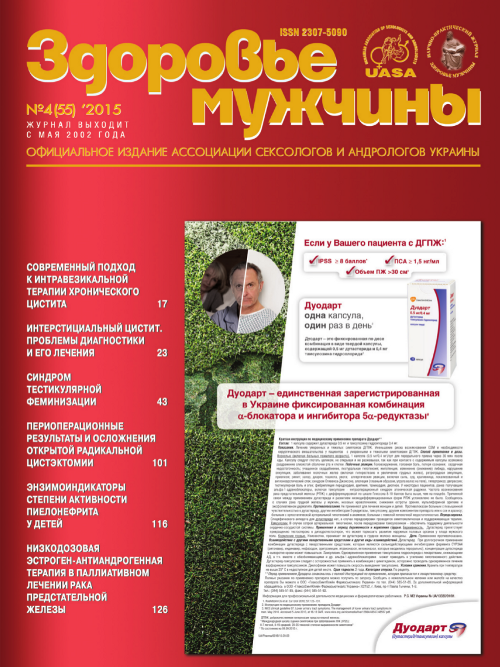Treatment results in patients with Stage IIA and IIB seminoma of testis
##plugins.themes.bootstrap3.article.main##
Abstract
##plugins.themes.bootstrap3.article.details##

This work is licensed under a Creative Commons Attribution 4.0 International License.
Authors retain the copyright and grant the journal the first publication of original scientific articles under the Creative Commons Attribution 4.0 International License, which allows others to distribute work with acknowledgment of authorship and first publication in this journal.
References
Classen J. Radiotherapy for stages IIA/B testicular seminoma: Final report of a prospective multicenter clinical trial / J. Classen, H. Schmidberger, C. Meisner, [et al.] // J. Clin. Oncol. – 2003. – V. 21. – P. 1101–1106.
Chung PW. Stage II testicular seminoma: Patterns of recurrence and outcome of treatment / PW. Chung, MK. Gospodarowicz [et al] // Eur. Urol. – 2004. – V. 45. – P. 754–759.
Gholam D. Advanced seminoma: Treatment results and prognostic factors for survival after first line, cisplatin based chemotherapy and for patients with recurrent disease: A single institution experience in 145 patients / D. Gholam, K. Fizazi, MJ. Terrier Lacombe [et al.] // Cancer. – 2003. – V. 98. – P. 745–752.
Arranz Arija JA. E400P in advanced seminoma of good prognosis according to the international germ cell cancer collaborative group (IGCCCG) classification: The Spanish Germ Cell Cancer Group experience / JA. Arranz Arija, X. Garcia del Muro, J. Guma [et al] // Ann. Oncol. – 2001. – V. 12. – P. 487–491.
Zagars GK. Mortality after cure of testicular seminoma / GK. Zagars, MT. Ballo, AK. Lee [et al] // J. Clin. Oncol. – 2004. – V. 22. – P. 640–647.
Incrocci L. Treatment outcome, body image, and sexual functioning after orchiectomy and radiotherapy for stage I II testicular seminoma / L. Incrocci, WC. Hop, A. Wijnmaalen [et al.] // Int J Radiat Oncol Biol Phys. 2002. – V. 53. – P. 1165–1173.
Krege S. Single agent carboplatin for CS IIA/B testicular seminoma: A phase II study of the German Testicular Cancer Study Group (GTCSG) / S. Krege, C. Boergermann, R. Baschek [et al.] // Ann Oncol. – 2006. – V. 17. – P. 276–280.
Bokemeyer C. Metastatic seminoma treated with either single agent carboplatin or cisplatin based combination chemotherapy: A pooled analysis of two randomised trials / C. Bokemeyer, C. Kollmannsberger [et al] // Br J Cancer. – 2004. – V. 91. – P. 683–687.
Culine S. Refining the optimal chemotherapy regimen for good risk metastatic nonseminomatous germ cell tumors: A randomized trial of the Genito Urinary Group of the French Federation of Cancer Centers (GETUG T93BP) / S. Culine, P. Kerbrat, A. Kramar [et al.] // Ann Oncol. – 2007. – V.18. – P. 917–924.
Kondagunta GV. Etoposide and cisplatin chemotherapy for metastatic good risk germ cell tumors / GV. Kondagunta, J. Bacik [et al.] // J Clin Oncol. – 2005. – V. 23. – P. 9290–9294.
Richiardi L. Second malignancies among survivors of germ cell testicular cancer: A pooled analysis between 13 cancer registries / L. Richiardi, G. Scelo, P. Boffetta [et al.] // Int J Cancer. – 2007. – V. 120. – P. 623–631.
Travis LB. Second cancers among 40,576 testicular cancer patients: Focus on long term survivors / LB. Travis, SD. Fossa [et al.] // J Natl Cancer Inst. – 2005. – V. 97. – P. 1354–1365.
van den Belt Dusebout AW. Treatment specific risks of second malig nancies and cardiovascular disease in 5 year survivors of testicular cancer / AW. van den Belt Dusebout, R. de Wit, JA.Gietema [et al.] // J Clin Oncol. - 2007. – V. 25. – P. 4370–4378.
Travis LB. Treatment associated leukemia following testicular cancer / LB. Travis, M. Andersson, M. Gospodarowicz [et al.] // J Natl Cancer Inst. – 2000. – V. 92. – P. 1165–1171.
Robinson D. Mortality and incidence of second cancers following treatment for testicular cancer / D. Robinson, H. Moller, A. Horwich // Br J Cancer. – 2007. – V. 96. – P. 529–533.
Schairer C. Comparative mortality for 621 second cancers in 29356 testicular cancer survivors and 12420 matched first cancers / C. Schairer, M. Hisada, BE. Chen [et al.] // J Natl Cancer Inst. – 2007. – V. 99. – P. 1248–1256.
Huyghe E. Fertility after testicular cancer treatments: Results of a large multi center study / E. Huyghe, T. Matsuda, M. Daudin [et al.] // Cancer. – 2004. – V. 100. – P. 732–737.
van den Belt Dusebou AW, Long term risk of cardiovascular disease in 5 year survivors of testicular cancer / AW. van den Belt Dusebout, J. Nuver, R. de Wit [et al.] // J Clin Oncol. – 2006. – V. 24. – P. 467–475.





